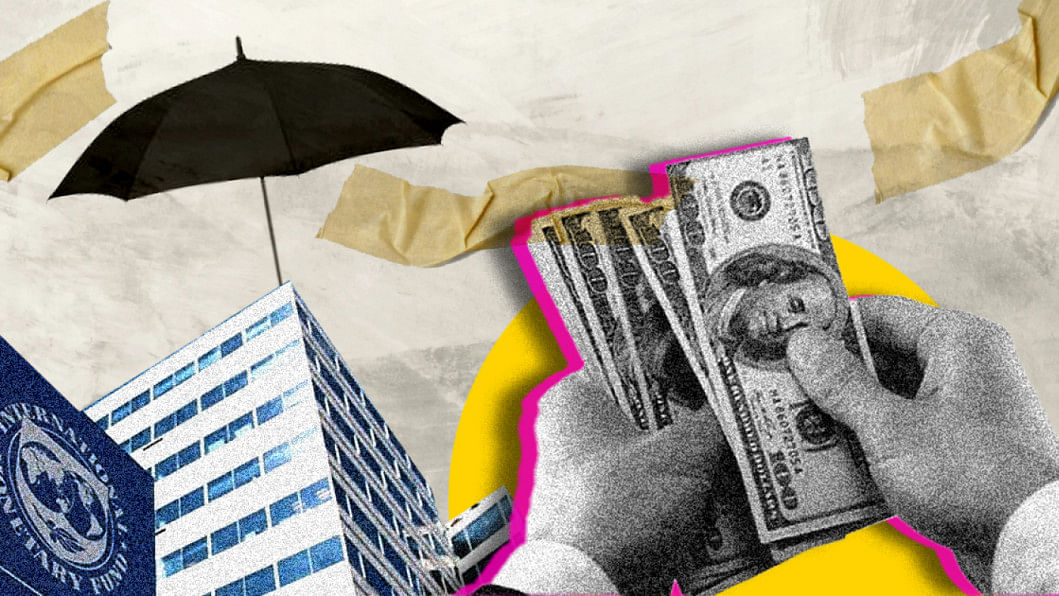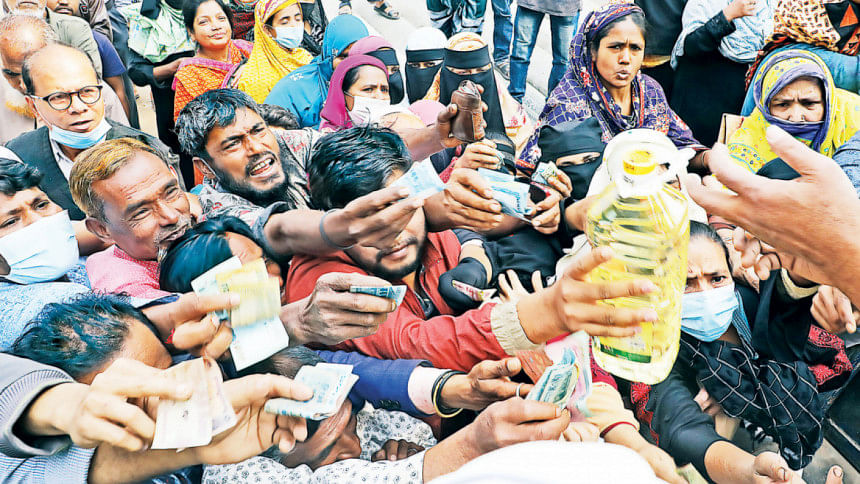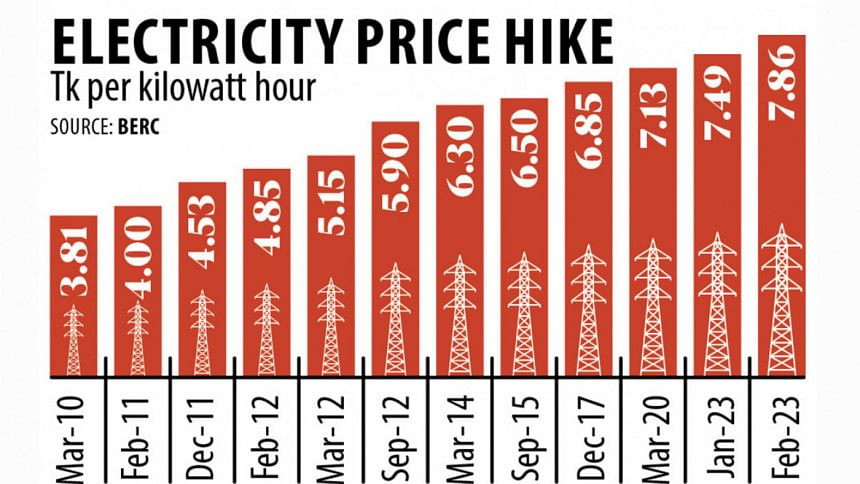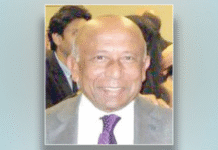
Economies around the world are in ferment. The disruptions experienced in 2022 following the outbreak of the Russia-Ukraine war was nothing short of a perfect storm for the global economy. The headwinds of that storm continue to ravage economies to this day. New and old elements of crises have emerged: global inflation, higher interest rates, appreciation of the US dollar, rising fiscal and current account deficits, and debt distress. Under this perfect economic storm and all its fury, Bangladesh’s economy buckled, but it did not break. However, challenges remain.
After the Covid-19 pandemic, there were talks of a debt pandemic around the world. According to the World Bank, debt distress has gripped 60 percent of all emerging markets and developing economies. The International Monetary Fund (IMF) has identified at least 53 most vulnerable economies, some of them on the verge of – if not already – approaching sovereign debt default. Ghana recently joined Sri Lanka in that latter group, with Pakistan not far behind.
Thanks to three decades of prudent macroeconomic management that ensured macroeconomic stability, the IMF found Bangladesh to have low risks of debt distress with adequate capacity to repay the Fund. A Debt Sustainability Analysis of IMF-World Bank assessed Bangladesh’s debt carrying capacity in the “medium” range. The total public debt was at 38 percent of GDP in FY 2021-22, external debt at 12 percent of GDP, and debt service payments of USD 3.7 billion in FY22 was barely five percent of the total foreign exchange earnings – all in a very comfortable range. Make no mistake: Bangladesh’s favourable standing on debt was a critical element in moving the multilateral agency to a quick decision.
So how do we read the IMF’s USD 4.7 billion loan facility executed within a record period of about six months, from the emergence of the global crisis, Bangladesh’s request for support under existing and new IMF facilities, agreement with the government, and the release of the first tranche in early February 2023? First, it was made clear by the IMF spokespersons that this was not a rescue package of any sort. It was clearly a pre-emptive measure to create adequate buffers to move the level of forex reserves to a comfort zone. I cannot recall another multilateral aid of such magnitude being released with such alacrity. It was a confluence of two factors: (a) recognition of the severity of the global crisis; and (b) Bangladesh’s need for timely support and its healthy record of servicing such multilateral debt without default or need for moratorium.
In these challenging times, among the many candidates for immediate BOP support from the IMF, Bangladesh surely stood out as most deserving and judged eminently qualified to undertake concessional debt with minimum risk for the lender. To be sure, the loans come with a reasonable agenda of reform efforts that have been mutually agreed between the IMF and the Bangladesh government – via an agreed Memorandum of Economic and Financial Policies (MEFP). The reform agenda include, according to most analysts, some activities that the government has already embarked on, and others that were long awaited, all of which in totality is expected to bring dynamism and rejuvenate sustainable development. As economists, we look at this as an opportunity for undertaking much-needed structural reforms that would have positive long-term impacts to cope with the impending graduation from the LDC status, along with the nation’s goals for reaching Upper Middle Income Country (UMIC) status by 2031. To be sure, without significant progress in financial sector reforms, revenue mobilisation efforts, facilitation of FDI and trade policy modernisation, these achievable goals could soon take the form of mirages.

A Bretton Woods Institution, the IMF was set up as a lender of last resort to provide BOP support in exactly the kind of situation Bangladesh economy finds itself in, due to exogenous factors over which the country had no control. The economy was on a path of robust recovery when the Russia-Ukraine war struck, leading to a sharp widening of Bangladesh’s current account deficit, depreciation of the taka and a decline in forex reserves. In consequence, Bangladesh’s economy is expected to be under BOP pressure for some time. Therefore, the arrangement of USD 4.7 billion under a 42-month programme is both timely and somewhat adequate to cope with the challenges at hand. The breakdown of the commitment is as follows: Extended Credit Facility (ECF) of USD 1.1 billion; Extended Fund Facility of USD 2.2 billion; and Resilience and Sustainability Fund (RSF) of USD 1.4 billion. This is Bangladesh’s 13th such arrangement.
Thanks to three decades of prudent macroeconomic management that ensured macroeconomic stability, the IMF found Bangladesh to have low risks of debt distress with adequate capacity to repay the Fund.
The days of tagging pre-conditions for loan disbursement by multilateral institutions are behind us. The current approach of such substantial commitment is to seek ownership of the authorities in undertaking long-felt needed reforms that are consistent with medium- and long-term goals of the economy – as demonstrated in medium-term (Five-Year Plans) or long-term (Perspective Plan) programmes. Evidence of that ownership may be found in the Letter of Intent (from the finance ministry) and the mutually agreed MEFP. In light of a fairly significant reform agenda in financial, revenue, and monetary management, let’s not underestimate the challenges that lie ahead for our policymakers to make good on the commitments. If done in right earnest, it opens the scope for the broadest range of economic reforms (plus climate-related activities) preceding the country’s graduation out of the LDC status in 2026.
No doubt, like many developing economies, Bangladesh has its own share of potential systemic risks, from low revenue mobilisation and weak financial sector, to a lack of economic diversification, rising inequality and poor governance. The design of the three-pronged IMF facility appears well-crafted and is expected to “advance reforms for inclusive, green and sustainable growth, while protecting macroeconomic stability, easing demand management measures and rebuilding buffers.” There can be little disagreement with any of these objectives given the state of our economy today. Of course, the proof will have to come in the pudding to follow.
The source of Bangladesh’s current economic predicament was the surge in imports in FY22 following supply chain disruptions stemming from the Russia-Ukraine war and its aftermath: price hike of food, fuels, fertiliser, energy, and other commodities. This upset the cart of Bangladesh’s macroeconomic stability via record trade and current account deficits, falling forex reserves, record one-time exchange rate depreciation, and high domestic inflation. Ensuring macroeconomic stability, getting the balance of payments on a sustainable path, and shoring up official forex reserves are really the core elements of the IMF programme, which also takes on board several long-standing reform imperatives in the financial sector and revenue mobilisation efforts. To end this brief note, I will dwell on how the IMF programme, and Bangladesh’s commitment, expect to resolve the core issue.
First off, there is the issue of what Bangladesh’s level of official foreign exchange reserves is. Here, Bangladesh has been following the standard statistical definition of Gross Official International Reserves (GIR) in accordance with the IMF Balance of Payments Manual (BPM6), which puts the GIR at USD 33.8 billion as of end-December 2022. However, when the IMF launches a programme like the one under review, they seek out official reserves that are “unencumbered” by any short-term obligations, as, for instance, would be the case with our Export Development Fund (EDF), which extends short-term loans to exporters that are serviced through export proceeds. Though yet to be formalised with a standard statistical definition, the Net International Reserves (NIR) is what the IMF would be looking at as they review Bangladesh’s commitment to hold and gradually accumulate forex reserves. The NIR was estimated at USD 27.5 billion as of end-October 2022. Given the current trends of LC opening, settlements, and customs-based imports, the NIR already provides coverage of four months of prospective imports, which is the target of the programme in the first year.
Challenging external developments came as a shock to Bangladesh’s economy, as it did to many other developing economies. Now, the mutually agreed IMF programme sets our economy on a path to macroeconomic stability and a sound, environmentally sustainable long-term strategy for green and inclusive growth – something that was an integral part of our long-term development strategy anyway.
The Bangladesh Bank is also committed to moving away from multiple rates towards a uniform and flexible exchange rate by the end of 2023. On this count, as well as the requirement that efforts are put in place (Budget FY 2023-24) to augment the tax-GDP ratio by 0.5 percent, it appears that the first review of the IMF programme, expected around September-October this year, should pose no problem in releasing the next tranche of about USD 650 million. A core principle committed to by the government under tax reforms is the overarching strategy of shifting the tax burden from trade-related taxes towards income and value-added taxes. Over time, this strategy will ensure modernisation of the tariff and protection structure, minimise anti-export bias that is stifling export diversification, and encourage foreign investors to invest in 21st century manufacturing enterprises in Bangladesh.

Since it was the unsustainable current account deficit (CAD) that brought the IMF programme to our shores, I notice in the IMF Report the rather conservative projections of CADs going forward. IMF projections may be somewhat off the mark. A review of import trends as of December 2022 (imports, LC opening and settlements) shows substantial weakening of imports over the coming months, suggesting the total FY23 imports of between USD 75 billion and USD 80 billion, and CAD below two percent of GDP, against the IMF projections of over three percent for the years FY23-27. International analysts put three percent of CAD as the red line to indicate that any economy running over three percent of CADs for three to five years will face a BOP and macroeconomic crisis. So, by no means should Bangladesh be running CADs of three percent or above during the years leading up to the LDC graduation. As far as the central bank is concerned, the existing curbs on imports along with exchange depreciation have worked so far in keeping prospective imports within range. But the professional advice should be to phase out the ad hoc measures and rely on the exchange rate instrument (which is market-based) to restore external balance. With exports and remittances – the two formidable foreign exchange earners – showing robust growth so far, I have no reason to believe that the economy will not return to its eminently sustainable historical CADs of 1-1.5 percent of GDP over the medium term.
One of the messy policies resorted to in the aftermath of the external shock was the ad hoc regime of multiple exchange rates (different exchange rates for exporters, importers and remittances). In an uncertain environment of forex availability, this unorthodox move has led to undue currency speculation and arbitrage among various players in the foreign exchange market. It is a relief to see that the authorities have fully understood the futility of this complex arrangement that is clearly not helping the return of stability in the exchange market. The programme’s emphasis on greater exchange rate flexibility to help accumulate reserves, strengthen external buffers, and build resilience is rightly focused. The return to a unified exchange rate and exchange rate flexibility is the orthodox move to restore BOP equilibrium over the medium term and to put an end to the speculative forces that have been recently rampant in the market. Most importantly, the IMF programme and government commitments by resolving the exchange rate, and the BOP issue is expected to ameliorate the “dollar shortage” conundrum that has bedevilled the market in recent months.
Last but not least, while focusing on growth and macroeconomic stability, the government and the IMF have not ignored the challenge Bangladesh faces as one of the most vulnerable countries to climate change. The USD 1.4 billion RSF is earmarked to shore up Bangladesh’s own medium- and long-term programmes of climate adaptation and mitigation envisaged under the Bangladesh Delta Plan, 8FYP and the Perspective Plan 2041. These resources will be a timely support for catalysing additional official and private finance, and enhancing the government’s climate mitigation (Nationally Determined Commitments) and adaptation programmes (National Adaptation Plan). Given Bangladesh’s aggressive commitment to building resilience against climate change, the disbursement of funds under this component is expected to be fairly smooth.
Finally, a crisis is a terrible thing to waste because it also presents opportunities. Challenging external developments came as a shock to Bangladesh’s economy, as it did to many other developing economies. Now, the mutually agreed programme sets our economy on a path to macroeconomic stability and a sound, environmentally sustainable long-term strategy for green and inclusive growth – something that was an integral part of our long-term development strategy anyway. The IMF programme support brings additional resources to cope with emerging and impending challenges to the economy as we prepare to transit into the United Nations’ group of developing economies in 2026 and cross the World Bank’s UMIC threshold by 2031.
Acclaimed as a successful case of development, following a transitory exogenous shock, Bangladesh is now presented with an opportunity to resume its development march with renewed vigour to achieve ambitious goals over the long haul.
Dr Zaidi Sattar is chairman of the Policy Research Institute of Bangladesh (PRI).










